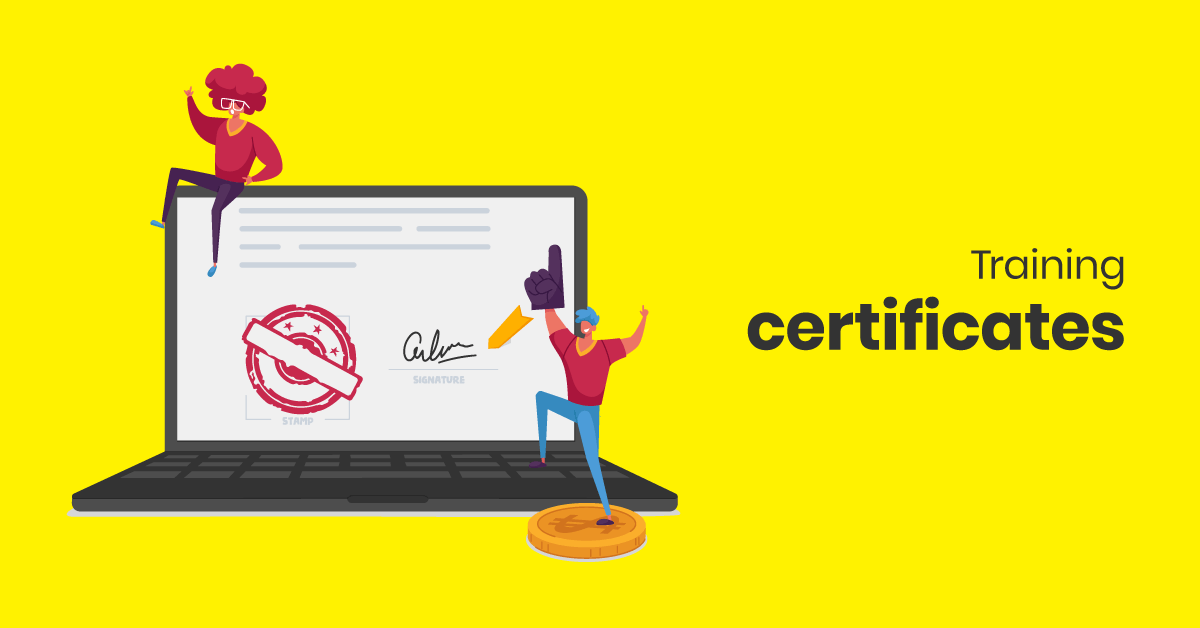A well-planned training certification benefits employees but also has big advantages for the organization that issues it. If you’ve been wondering about offering training certification to your employees, now may be the time to jump in.
Why you should offer training certificates
Certification acts as a benchmark for development. It makes it easy for employees to show off their expertise and competencies. This kind of recognition is generally linked to training that will boost people’s careers. It’s common in role-specific training like HR or project management (think SHRM or PMP) or technical skill development around specific software.
Employees can also earn corporate training certificates in soft skills training by completing courses in things like communication and negotiation.
Whatever the content, a training certificate establishes expertise and ensures employees are up-to-date with the latest developments in the topic at hand. This is reason enough to consider adding a formal acknowledgment of achievement to your online course.
But there’s more. Here are just a few ways training certification can benefit your company.
- Motivate training completion. Formal recognition inspires employees to complete their training because they get a visible, short-term goal. Long-term rewards associated with training can sometimes take weeks or months to manifest. A certificate that represents the coursework they’ve done is something employees can hold onto now. It can motivate them to move through their training at a good pace and see it through to the end.
- Build employer brand awareness. When employees share their certificates with their network, others see your company as a place where learning and development thrive. You build brand awareness and authority in your field when you provide tangible evidence of the knowledge or skills you offer.
- Boost employee engagement. Continuing education opportunities and achievement recognition help employees feel valued. How is that a benefit to your organization? In one study, 82 percent of employees say they’re happier with their jobs when they feel recognized at work. And happier employees mean higher engagement, productivity, and retention.
- Attract top talent. As you establish yourself as an authority or thought leader, people will gravitate toward your organization. Your commitment and contributions to your field are on display with each certificate.
- Increase customer trust. Certification shows customers your employees have the skills and knowledge required to do their jobs. Customers will see that you hold employees to a high standard of expertise and know they’re in good hands. Proof of accomplishment and learning can also help you (and your customers) be sure your workforce is up to speed with any legal or compliance requirements.

6 best practices for effective training certification
There’s plenty of reason for you to offer certification with your online courses. But where do you start? What do you need to know to make sure you’re offering (and receiving the benefits of) a valuable addition to your continuing education?
Here are six things you can do to establish and roll out certification aligned with your training goals.
1. Start with the right LMS
A Learning Management System (LMS) with the proper features is key to creating and hosting a certification program. You need one that can administer courses and track learners as they go through them. It should offer options for assessing when employees earn the certificate and should then be able to issue it seamlessly.
For example, a platform like eFront makes your job easier with built-in features for creating and hosting a certification program. With ready-to-use, easy-to-customize templates, you can design and offer training certificates in a snap. This fully adaptable LMS can administer the courses and testing needed to certify, then issue the document. It will track data so you see which employees have already finished their training and when their certificates expire. It will also notify learners when it’s time to recertify.
The right LMS will take care of the heavy lifting, leaving you free to focus on curating the perfect content and building effective training.
2. Set the criteria for certification
Credentials are most useful when they’re earned. Offer a certificate of training that shows learners have proved their knowledge or skills. You may attach it to a test that demonstrates understanding and ability. Or, you can make it dependent on an interactive course that requires participation.
Whatever path you choose, the document will mean something more when employees have to work for it versus when they’ve just been present. Passive observation won’t carry the same weight or feel as valuable. Certification should reflect real learning and growth — employees should post it with feelings of accomplishment and pride.
3. Make milestones clear
Keep learners motivated with a roadmap of manageable tasks. For example, what activities will they need to engage in to get a training certificate? What learning modules will they have to complete? What tests or quizzes will they need to pass? Is the certificate dependent on a series of lessons in one course, or does it require completion of multiple courses?
Make sure all requirements are clear and achievable. Outline the milestones to completion upfront so employees have a clear path to follow. Knowing the end goal from the beginning will help them move from one key step to the next.
4. Determine whether certificates should expire
In programs like compliance training, you may want to indicate that certificates expire. These courses ensure participants keep up with changing industry information or standards. That means the information will need to be reviewed periodically as regular updates are made to the training resources.
If this is an important requirement for your training, set a clear expiration date. When the renewal date draws nearer, set triggers so people know what to do to renew their certificate.
5. Customize the certificate to reflect your brand
Add value by letting people know you’re the source of the certificate. Make it part of your brand with recognizable visuals. For example, use the features available in your LMS to match the certificate to your company. Add your logo to the design and choose a template that reflects your colors and branding.
This kind of customization will help learners feel the kudos and authority comes directly from your organization. It will also expand brand awareness outside your organization. Wherever the certificate is displayed, it will associate your company with the skills you value and teach.
6. Enable — and encourage — social media sharing
When employees put in considerable work and effort to learn new skills, they’ll want full credit. Give them the chance to show the world what they’ve achieved. Enable social media sharing so they can post the certificate to their LinkedIn and Facebook profiles or share it on Twitter.
This easy-to-share recognition is a boost for employees and also amplifies attention for your organization.
Conclusion
From software to soft skills, training certification ensures your employees maintain the highest standards of competence. This in turn boosts employee morale and customer confidence in your organization.
The right certification program can help you develop your teams and establish your company as a leader in your industry. Add certifications to your training easily and intuitively with the right LMS, and take advantage of all they offer.



